

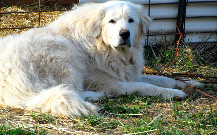
Basic Terms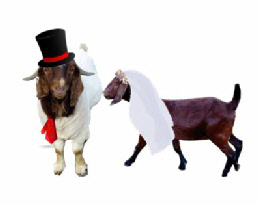
Doe = female goat
Doeling = young female goat
Buck = male goat
Buckling= young male goat
Kids = young goats
Trip = a herd of goats
Dam = mother
Sire = father
Goat Breeds
More detailed information about goat breeds can be found at: <http://www.ansi.okstate.edu/breeds/goats/>
The pictures of each breed are the 2012 National Champions for that breed taken from the respective breed registry web page. Visit the breed registries for more information about different breeds of goats.
Dairy Goats
The American Dairy Goat Association recognizes eight breeds: Saanen, Toggenburg, Alpine, LaMancha, Nubian, Nigerian Dwarf, Sable, and the Oberhasli.
Saanen
The Saanen is one of the most widely distributed dairy goat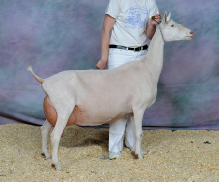 breeds
in the world. It is next in popularity to the Nubian. The breed was developed in
the Bernese Oberland, the western and northwestern part of Switzerland. Saanens
are considered to be the best milkers in Switzerland. Saanens are the largest dairy
goats and are colored white or light cream. Spots on the skin and small spots of
color are allowable but not desirable. Does should be feminine and not coarse. A
Saanen’s face should be straight or dished and the ears should be erect and alertly
carried.
breeds
in the world. It is next in popularity to the Nubian. The breed was developed in
the Bernese Oberland, the western and northwestern part of Switzerland. Saanens
are considered to be the best milkers in Switzerland. Saanens are the largest dairy
goats and are colored white or light cream. Spots on the skin and small spots of
color are allowable but not desirable. Does should be feminine and not coarse. A
Saanen’s face should be straight or dished and the ears should be erect and alertly
carried.
Saanens are good milkers. The all-
Toggenburg
Toggenburgs are the smallest of the Swiss breeds of Dairy Goats. The face is straight or dished (never Roman) and the ears are erect and carried forward. Toggenburgs have a specific color pattern: They have a solid color ranging from light fawn to dark chocolate with distinct white markings. The white markings are the following:
- White ears with a dark spot in the middle
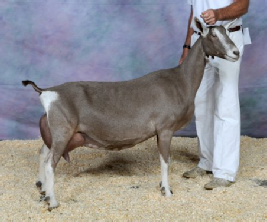
- Two white stripes down the face from above each eye to the muzzle
- White hind legs from hocks to hooves
- White forelegs from the knees downward
- A white triangle on either side of the tail
The Toggenburg is the oldest registered breed, with a herd book established
in Switzerland in the 1600s. In 1893, William A. Shaffer of Ohio imported four Toggenburgs
from England. This is said to be the first known importation of any registered Dairy
Goats to this country. The poet Carl Sandberg had a well-
The Toggenburg all time record is an amazing 7965 lbs., equal to 995 gallons a year. They are also known to be persistent milkers, milking beyond the standard 305 days.
Alpine
Alpines are a hardy, adaptable Swiss breed that thrives in most climates while
maintaining good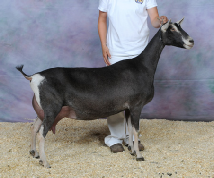 health and excellent production. The average milk production of
an Alpine is 2031 lbs. and 3.5% butterfat. The record, set in 1997, is 6414 lbs.
An Alpine holds the all-
health and excellent production. The average milk production of
an Alpine is 2031 lbs. and 3.5% butterfat. The record, set in 1997, is 6414 lbs.
An Alpine holds the all-
Alpines are medium to large goats with erect ears and a straight nose. They can be any color or combination except those of the oberhasli, toggenburg, and saaanen.
LaMancha
LaManchas are easy to recognize. They have small external ears. They can
be any color or color combination. They should have faces that are straight, or
slightly dished and well-
There are two types of ears: the gopher ear and the elf ear. The gopher ear
has a maximum length of approximately 1-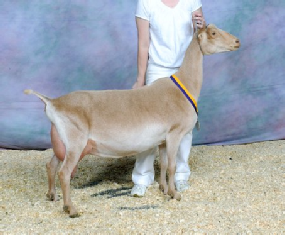 d
the end of the ear must turn up or down. A buck must have gopher ears in order to
be eligible for registration. The elf ear has a maximum length of approximately
2 inches. Like the gopher ear, the elf ear the end of the ear must turn up or down,
But cartilage shaping the ear is allowed. Does may have either ear in ordered to
be registered. LaManchas have excellent dairy temperament and are very productive.
d
the end of the ear must turn up or down. A buck must have gopher ears in order to
be eligible for registration. The elf ear has a maximum length of approximately
2 inches. Like the gopher ear, the elf ear the end of the ear must turn up or down,
But cartilage shaping the ear is allowed. Does may have either ear in ordered to
be registered. LaManchas have excellent dairy temperament and are very productive.
Nubian
Nubians are one of the most popular dairy goat breed in the U.S. They are
large goats with long, pendulous ears. The ears are thin, with well-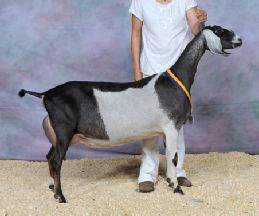 color, solid or patterned, is acceptable. Nubian does tend to be beardless.
The facial profile between the eyes and the muzzle is convex. They are more restless
and tend to be more vocal than other breeds.
color, solid or patterned, is acceptable. Nubian does tend to be beardless.
The facial profile between the eyes and the muzzle is convex. They are more restless
and tend to be more vocal than other breeds.
Nubians produce premium quality milk with a butterfat content higher than
the other breeds. In general, they are not heavy milkers as some breeds but the
milk is very rich. Nubians are believed to be from Nubia-
Nigerian Dwarf
Nigerian Dwarves were introduced in the early 1980s when they were mostly seen in zoos. They have roots in Africa but were developed in the U.S. They have a similar conformation to that of larger Dairy Goats.
A well-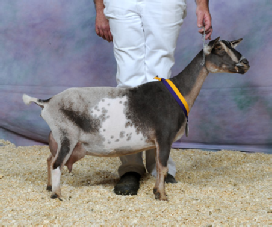 Dwarf milk is higher in butterfat (6-
Dwarf milk is higher in butterfat (6-
Nigerian Dwarfs have gentle, friendly personalities that make them good pets. Even breeding bucks are handled easily. Breeders of other types of goats find that their Dwarfs blend in with the rest of their herd and do not need special quarters; just adequate fencing to contain them because of their small size.
Although they have similar origins, Nigerian Dwarfs and African Pygmies are separate and distinct breeds. Pygmies are bred to be "cobby" and heavy boned. Dwarfs are bred to have same dairy characteristics as the larger breeds. There is no color discrimination among Nigerian Dwarfs under AGS (American Goat Society) registry. Under NDGA (Nigerian Dwarf Goat Association) registry policy, pygmy coloration and pattern is a minor fault.
The AGS breed standard sets the maximum height for does at 22.4" with bucks up to 23.6". NDGA maximum heights for does and bucks is 21" and 23", respectively. There is no minimum height; although NDGA specifies an "ideal" height between 17" and 19" for does and 18" to 20" for bucks.
Oberhasli
In Europe, the Oberhasli has been known as the Oberhasli- called Swiss Alpines. In 1978 the American Dairy Goat Association
(ADGA) changed the name to Oberhasli.
called Swiss Alpines. In 1978 the American Dairy Goat Association
(ADGA) changed the name to Oberhasli.
The milk production of this breed is moderate with fairly high
butterfat. These goats are medium sized, often long-
1) Two black stripes down the face from above each eye to a black muzzle
2) Forehead nearly all black, black stripes from the base of each ear coming to a point just back of the poll and continuing along the neck and back as a dorsal stripe to the tail
3) Black hocks
4) Ears black inside and bay outside.
Meat Goats
Pygmy
Pygmies are counterparts of the Nigerian Dwarf but are more “cobby”, or stocky. Pygmies
are descended from the African Cameroon Dwarf Goat. The first documented shipment
of pygmies arrived 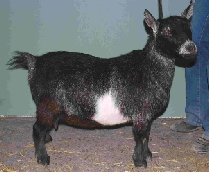 in California and New York in1959.They were first seen in zoos
in the U.S. in the 1950s.
in California and New York in1959.They were first seen in zoos
in the U.S. in the 1950s.
Pygmies are only 16 to 23 inches tall at the withers at maturity and does weigh
only 50 lbs. The coat is straight, of a medium length. On males, a long, full beard
is desirable. They are usually agouti, salt and pepper, but are acceptable in any
colors. Some are said to produce as much as 4 lbs. Of milk a day. Their lactation
period is only 4-
Kinder Goats
Kinder Goats are Nubian/Pygmy Crosses. The Kinder goat is a appealing and produces both meat and milk. Their milk has a very high average butterfat content. The Pygmy side of the cross gives the Kinder goat a smaller size. Kinders have a year round breeding season and produce kids in multiple births.
The Nubian side of the cross gives the Kinder larger legs and larger teats, which makes milking much easier. The large size of the Nubian means more milk is produced. The Kinder also has Nubian ears and the wide range of colors
Many Kinders produce 4-
Kinders are registered by the Kinder Goat Breeders Association.
Boers
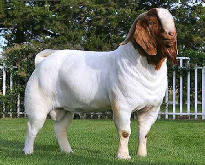 Boer Goats are large meat goats, with origins in South Africa. They are registered
by the American Boer Goat Association. The main objective for Boer goats is to
have a suitable size with maximum meat production. The ideal Boer goat has red hair
on the head and ears and white on the rest of the body. Boer goats have a docile
disposition which makes them easy to raise.
Boer Goats are large meat goats, with origins in South Africa. They are registered
by the American Boer Goat Association. The main objective for Boer goats is to
have a suitable size with maximum meat production. The ideal Boer goat has red hair
on the head and ears and white on the rest of the body. Boer goats have a docile
disposition which makes them easy to raise.
Fainting Goats
Fainting Goats, also called Tennessee goats, are goats that carry the recessive gene for Myotonia Congenita. When the animal is startled its muscles lock up. Reactions can be as mild as a hobble or stiff leg or as severe as falling over.
The history of fainting goats begins with a man named Tinsley who came to Marshall County, Tennessee, in 1880, with four goats with the fainting trait. Tinsley worked on a local farm and left the goats behind when he left.
Fainting goats are easy kidders and wonderful mothers. They are excellent meat animals because of the Myotonia which causes the build up of heavy muscles. Tennessee goats have been crossed with other goat breeds to preserve the fainting trait.
Fiber Goats
Angora
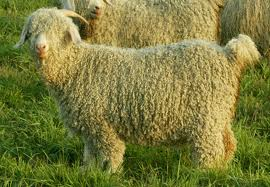 The Angora goat produces mohair, a long, lustrous, fleece. They originated
from the province Angora (now Ankara) in Turkey. Mature bucks weigh around 150 pounds
while does weigh around 85 pounds. Angoras are usually pure white, but occasionally
there are black Angoras. A good angora should have fleece covering all parts of
the body except the face and should be of a fine quality.
The Angora goat produces mohair, a long, lustrous, fleece. They originated
from the province Angora (now Ankara) in Turkey. Mature bucks weigh around 150 pounds
while does weigh around 85 pounds. Angoras are usually pure white, but occasionally
there are black Angoras. A good angora should have fleece covering all parts of
the body except the face and should be of a fine quality.
Does and kids produce 3.5 to 4.5 pounds of mohair while wethers produce 4 to 5 pounds. Angoras are usually horned with long, thin, pendulous ears.
Cashmere Goats
Cashmere goats produce cashmere, which is goat down. Clothing made from Cashmere is expensive because it is very light, soft, and warm. Cashmere goat is not really a breed but is a name of goats that produce marketable amounts of cashmere. There are several varieties. Cashmere goats originated from the Central Asian mountains in Kashmir. Cashmere goats were introduced into the U.S. primarily from Australia where it was discovered that their feral oats produced cashmere. Raising Cashmere goats can be a very expensive enterprise because cashmere goats only produce around ½ pound of cashmere and it takes a lot of time to comb or shear the cashmere.